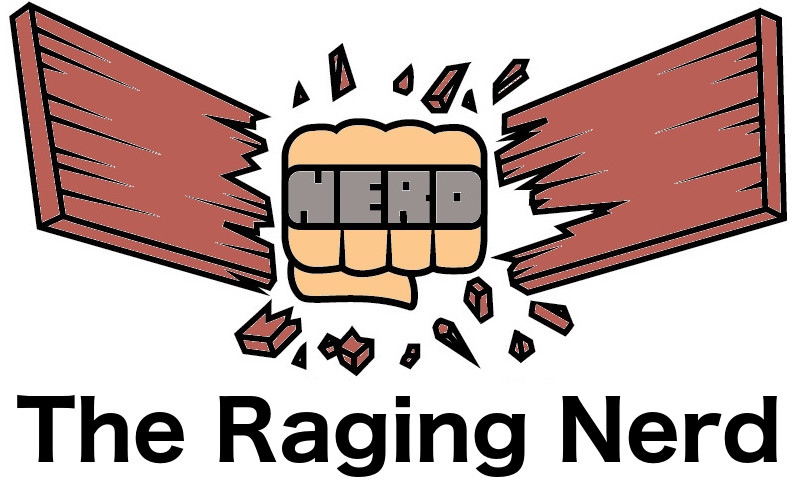- He presided over the bloodiest war in American history. While the total casualties from the Civil War were lower than many other wars that the United States has been involved in, the Civil War remains the single greatest loss of American lives. Over 620,000 casualties, a whopping 2% of the population, was dead by the end of the war. Interestingly, the United States fights most of its wars far away from its home turf. The World Wars, along with many of the USA’s other military engagements, all involved force projection far beyond American borders. Even Pearl Harbor was an attack on Hawaii, which was a territory and not on the mainland. The Civil War was the single most devastating war for the United States in a domestic sense. In a way, this speaks to the warfighting prowess of the USA: the most damage ever inflicted on the country was by Americans!
- He was assassinated. In one sense, this is less extraordinary than its sounds: of all the American presidents that have served, nine have been the subject of an assassination attempt, with four being successful. That means that, on average, one in five American presidents will experience an attempt on their life. What was extraordinary in Lincoln’s case was the way that the assassination worked out: Lincoln had already accomplished what he set out to do at his election, so the assassination was not out of political calculation. It was purely out of spite. John Wilkes Booth wanted to avenge the South. Even more bizarrely, Lincoln had a premonition three days prior, in which there was a corpse in the White House. He asked one of the guards in his dream who was dead, and the guard told him that it was the President, who had died at the hand of an assassin. Lincoln was also the very first president to be assassinated.
- His eerie parallels to JFK. Abraham Lincoln was assassinated by John Wilkes Boothe, who ran from the theater, and was eventually caught in a barn. JFK was assassinated by Lee Harvey Oswald, who ran from a warehouse and was apprehended by police in a theater. If a barn is basically an agricultural warehouse (and it is), Boothe ran from a theater to a warehouse, and Oswald ran from a warehouse to a theater. Kennedy had a secretary who warned him not to go to Dallas, and that secretary’s last name was Lincoln.
- Finally, his face. Abraham Lincoln was noted as an extremely unattractive man with a very asymmetrical face. That asymmetry, however, also made him look very distinctive. Unlike George Washington and other Presidents who looked similar to other men of their era, Lincoln’s face is unforgettable and would never be mistaken for anyone else. A fun story: Lincoln was once accused of being “two-faced” by a woman who confronted him on a train. He responded, “If I had two faces, do you think I’d be wearing this one?”
What Made The Atari 2600 Great
Atari is not really a household name anymore, but dedicated nerds know what Atari was. Long before the X-Box and PS4, the two big contenders were Sony and Nintendo. Before that, Sega was in the fray as well. And before all three of those, all the way back in the late 1970s, there was Atari. Even if you’ve never heard of Atari, you’ve probably heard of Pong. Pong was the world’s first coin-operated arcade game, and it was a huge success. Pong made a big splash. In fact, one of the first mass-produced consoles was a console that did nothing but play Pong. Both the Pong arcade game and the Pong console were created by Atari.
But Atari’s big contribution was the Atari 2600. What was the Atari 2600? Simply put, it was one of the first mass-produced consoles that worked off of ROM cartridges. ROM stands for Read Only Memory, meaning memory that is only read and never altered. The game cartridges that were common to the NES, SNES, Nintendo 64, and Sega Genesis were all ROM cartridges. Many such cartridges also had a small amount of static RAM in them, which made it possible to save your game. Static RAM, or Random Access Memory, is similar to the RAM in your computer, except it doesn’t clear when you turn the system off, unlike your computer’s RAM. While the Pong system was confined to only one game, the Atari 2600 allowed for removable carts. Given the fact that the Atari 2600 cost $200 (more than $800 in today’s money), it stands to reason that it needed the capacity to play multiple games. Few people would want to pay $800 just to play a single game!

an atari video game shirt
The Atari 2600 was great because it brought arcade gaming into the home. That was ultimately the trick: instead of having to go out and pop coins into an arcade machine to play a game, you could have that entertainment in your living room. And indeed, the “homeliness” of the Atari 2600 was intentional and reflected in its design. The original console had a wood grain finish. The point of giving it a wood grain finish was to make it fit with the decor of the average person’s living room. The “now you can play at home” vibe was completely intended by Atari.
Of course, there is plenty of history since the late 1970s in the gaming world. The NES was yet to come. Sega would still make its mark. And Atari itself was comparatively short-lived because of all the competition. Following the release of Pong, several competitors in the arcade market immediately sprang up. The same thing happened after Atari switched to at-home consoles. This meant that Atari quickly fell into financial trouble because it couldn’t move enough units, and the Atari 2600 itself cost nearly half a million in 1970s dollars to develop. So while Atari was not a terribly long-lived brand, it still left a significant mark with the Atari 2600. This is why you can still see the Atari logo on video game shirts.
Book Review: Jurassic Park
Michael Crichton’s Jurassic Park is almost an underrated book. This might sound like a weird thing to say. Jurassic park is very famous. So how is it underrated? The answer is simple. The movie overshadows the book. Jurassic Park is famous as a movie more than a novel. And we associate Spielberg with it more than Crichton. Spielberg is famous for directing the movie. Crichton has almost been forgotten. So the book, which is very good, deserves a treatment of its own. Let’s get into it. First, I will tackle the characters. Then, I’ll take a look at the underlying ideas. Then, I’ll look at some of the flaws. Finally, we’ll have a wrap-up.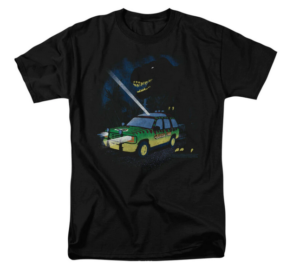
First, the characters. The main character, Dr. Alan Grant, is very compelling. He’s likeable. He remarks that he likes children because they have one thing in common: a love of dinosaurs. He’s unpretentious. He’s an academic, but not like other academics. He likes to dress casually and be down to Earth. And he enjoys getting his hands dirty. He’s not fond of computers. Remember that this was written back in the 90s when familiarity with computers was not taken for granted. We also have Ian Malcolm, who is egotistical and over-the-top but still likeable in his eccentricity. And we have Hammond, the owner of Jurassic Park, who is childish and petty.
The underlying idea of the book is chaos theory. The idea is that human reasoning can’t understand nature. The real world is too complex for our basic linear thinking to comprehend it fully. So our plans will always become messed up because we don’t appreciate complexity. The real world is always a step ahead of us. We might think we have it all figured out. But we don’t, and that will come back to bite us every time.
The big flaw in the book is how dated it is. I talked about the 90s feel of it earlier. The other part is the use of computers. Some parts are not very believable. There is a part where a pair of young children hack into a computer. This would have been believable in the 90s, when few people understood computers. Thirty years later, it’s not believable. We’re all familiar with computers now. And we all know they don’t work that way. But in the 90s, the average adult could almost believe that kids, who always seem to know how to use computers, might be able to do such a thing. So the book is a little dated in the final analysis.
Finally, to wrap it all up, I think that this is a book very much worth reading. It’s not as good as some of Crichton’s other books. Books like Sphere are more well-written and examine the limits of human reasoning more closely. And Crichton raises more challenging ideas in his other books. But Jurassic Park is still a great novel that raises some fascinating problems. There is a reason that people still wear Jurassic Park t shirts.
Cross-Trained Martial Artists Throughout History
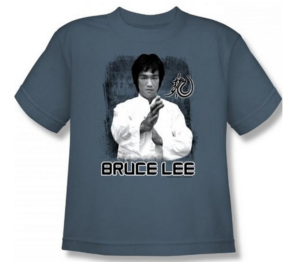
A martial arts movie t shirt featuring Bruce Lee
Mixed Martial Arts exploded in popularity in the 2000s. Promotions have come and gone: UFC, Pride, Dream, StrikeForce, Elite XC, and more. There is a distinction here that you must be careful to make: the sport is mixed martial arts. UFC, and all the others, are promotions. So UFC is to MMA as the NFL is to football. Many people enjoy modern MMA, and most of us understand that it involves a mix of styles. What a lot of people don’t know, however, is that the idea of cross-training between martial arts is not new. Many of the most famous martial artists throughout history have cross-trained and learned multiple fighting styles. And hybrid styles are as old as martial arts itself. Here’s a list of several different historical figures who were famous for reasons besides fighting, but who were cross-trained in many different martial arts styles. You may not have seen them on a martial arts movie t-shirt, but they’re important figures nonetheless.
One that may surprise you is Teddy Roosevelt. Most people know of Teddy Roosevelt as the American president famous for his pince-nez glasses and his involvement with the Panama Canal. What a lot of people don’t know is that Teddy Roosevelt also had extensive experience in both jiu jitsu and boxing. He was blind in one eye as a result of an injury sustained while boxing with an Army officer. His involvement in jiu jitsu is even more fascinating: he learned from Yamashita Yoshiaki, a direct student of Jigoro Kano. Jigoro Kano, incidentally, was the founder of Judo. Judo consists of a number of ancient Japanese jiu jitsu techniques codified into a single sport, and Kano’s pupil Yamashita taught those same techniques to Teddy Roosevelt.
A less well-known, but equally interesting practitioner of cross-trained martial arts was E.W. Barton-Wright. Living in the early 20th century, Barton-Wright combined Western boxing and wrestling with jiu jitsu and staff fighting to create a unique martial art he called bartitsu. He even sent letters to Jigoro Kano asking him to send jiu jitsu teachers from Japan to teach at his new bartitsu club. The martial art of bartitsu would later come to the attention of Arthur Conan Doyle, who would incorporate the art as a plot element in his Sherlock Holmes books.One final figure that you may have heard of, but who bears mentioning anyway, is Bruce Lee. While the idea of cross-training has existed for as long as martial arts, Bruce Lee was the person who popularized the idea in modern culture. His martial art, Jeet Kun Do, aims to “use no way as way” by combining whatever styles work best. Each individual practitioner does things differently. Jeet Kun Do is not a distinct art so much as a method for constructing martial arts from scratch.
What’s Special About It?

A Stephen King nerd t shirt
Stephen King’s It has a special place in our culture. King is a prolific author of over 81 books and is known for producing an exceptional amount of copy. Of all popular writers, King is one of the most productive. And yet, many of his other well known works, such as The Stand and the Dark Tower series, do not have the popularity of It. A niche audience may understand a reference to the Dark Tower, and a fair amount of people have seen one of the miniseries adaptations of The Stand. But everybody over the age of twelve seems to know who Pennywise is, even if they only know him as “the clown from that one movie” or have seen him on nerd t shirts. So what gives? What makes It stand out from the rest of King’s oeuvre?
First of all, It exploits a common fear: coulrophobia, also known as fear of clowns. Many people are afraid of clowns, but most of them are unaware that this is a common fear. By disguising his monster as a clown, King plays two games at once. First, he exploits coulrophobia. Second, he can make his monster seem innocent while at the same time using the creepiness of clowns to suggest that there is more to Pennywise than meets the eye. Pennywise is an iconic monster, alongside Freddy Krueger and Jason, because the clown persona allows him to occupy an uncanny valley.
Second of all, the worldbuilding behind the novel gives it depth. There is an entire cosmology behind It, including a pantheon of multi-dimensional gods. Unlike the Lovecraftian cosmology, which is amoral and inscrutable, the gods in this cosmology have a noticeable moral bent: some of them are good and some of them are evil. There is a multi-billion year story behind the whole thing, how It ended up in Derry, Maine, and why it does the things it does. Pennywise is not just a creature with a backstory. It is part of an entire world crafted for the sake of convincing horror.
This stands in stark contrast to pulpy pop horror, such as Nightmare On Elm Street and Friday The 13th. Freddy Krueger and Jason Voorhees are certainly memorable villains, but their worlds have very little depth. They have comic book-esque origin stories, they do stuff in the movies, and that’s it. By contrast, the cosmology behind It provides a deeper level of interest beyond the cinematics. Pennywise the Clown is an icon, just like all the other 80s horror monsters. But behind that cinematic icon, there is a deeper story. Other horror monsters get your attention and then let it go right away. Pennywise gets your attention and then keeps it with the long, fascinating backstory and cosmology.The first reason here explains what makes Pennywise an icon. The second reason explains how It goes beyond being a pulp horror trope and into something greater. These two together are why you can still see Pennywise everywhere: in comedy rap battles, on “we all float down here” t shirts, and even as collectible figurines.
Reading Your Cat’s Tail

A bengal cat tee shirt
Cats are such mysterious creatures. Unlike dogs, which heed our every command and understand our emotions and even make faces like we do, cats are otherworldly. They’re whimsical, fickle creatures. Cats can change their mood suddenly. They can snub you for a long and then take a liking to you out of nowhere. And many of the things that cats do seemingly have no explanation at all. This is one reason they’re so fascinating, and why they appear in so many memes and on meme shirts.
But, a cat’s emotions are not entirely opaque. By looking at your kitty’s tail, you can tell all sorts of things about her. Just as humans carry our emotions in our body language, cats carry their emotions in their tails. Keep an eye on your kitty’s derriere to learn all sorts of things about him.
When your cat holds her tail high and crooks the end slightly, she is friendly. You will notice that your cat often greets you by raising her tail and running up to you when you come home. Holding the tail high is a way of saying hello. You may notice that your cat also mews or trills when running up to you with her tail held this way.
When your cat is frightened or anxious, her tail may become puffy. The hair on just her tail stands on end so that it appears fatter. She may also behave erratically, making quick motions or overreacting to small sounds. When your cat is behaving like this, she’s anxious and may need some reassurance. If her tail becomes thick and she arches her back and hisses, she’s absolutely terrified and should be left alone until she can calm down a bit. Get out of the way and let her find a place to hide!
If your kitty holds his tail low to the ground, keeps his head low, and looks side to side slightly while walking forward, he’s hunting. There may be a small mouse or other edible little creature around. One really entertaining fact about this body language is that it’s also common with lions and other big cats. If you watch a lion or tiger hunting, you’ll see that they frequently adopt this posture.
Why Nerds Love Lincoln

An Abe Lincoln tee shirt.
If you grew up in the United States, you know who Abraham Lincoln is. He’s on our money. He’s on Mount Rushmore. There’s a Lincoln Memorial with a larger-than-life statue of him. There are . Five dollar bills feature his face and the Lincoln Memorial. Pennies feature the Lincoln Memorial and, until recently, had a tiny, almost invisible imprint of the Lincoln statue itself inside of the memorial. That imprint can be seen with a magnifying glass or jeweler’s loop.
We all know that Abraham Lincoln freed the slaves, but his presidency was unique for a number of other reasons. Some of these are well known, and some of them are more obscure. Let’s go through:
Japanese Cat Myths
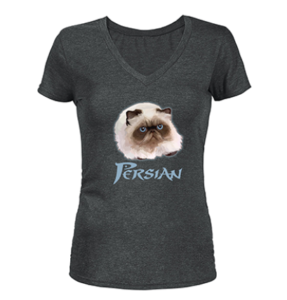
a funny t shirt featuring a cat
Cats are well-loved in Japan. For centuries, they’ve been the focus of Japanese folklore and myth. In Japanese military culture, there is a philosophy of a one-hit-kill. The ideal strike with a katana decapitates a foe in one blow. The ideal Judo throw ippons an opponent in one smooth motion. In each case, the idea is to attain victory in a single, perfect stroke. This philosophy, oddly enough, is exemplified by the common house cat. House cats pounce from tree branches, or leap into the air and intercept birds in mid-flight. They kill mice by toying with them and tiring them out for several minutes before delivering a single fatal strike. In a way, the cat fights in a manner that is congruent with Japanese martial philosophy.
Housecats have another side in the Japanese psyche, though. While they are seen as helpful and beneficent creatures, they also have a dark side. In Japanese folklore, there is a class of spirits called yokai. They’re also known as Mononoke, a word you may recognize from the name of a popular anime series. Yokai are sometimes good spirits, but just as often, they are mischievous or downright malevolent. And there are several kinds of cat yokai.
One such yokai is the nekomata. Nekomata originated in Chinese folklore. After about six centuries, they began to appear in Japanese folklore as well. There are many different kinds of nekomata and they have different properties depending on what period in Japanese history the legend comes from. One such legend claims that nekomata occur when domestic cats grow old enough to transform into fiendish and mischievous cat yokai. Some nekomata are created when ordinary cats run away to live in the mountains. As they grow older, they begin to stand on two legs and acquire human-like intelligence. They also grow an additional tail. Some nekomata retain the appearance of domestic cats except for the two tails. These nekomata can cause poltergeist activity in a person’s house.
Another example is the bakeneko. This cat yokai is similar to the nekomata. It is distinct from the nekomata in that it only has one tail. The bakeneko is a cat yokai that is known for displaying human-like characteristics. It sometimes walks on two legs or dances. It can also sing or speak like a person, possess people like an evil spirit, and control wildlife, such as wolves.
In both cases, cats are commonly seen as yokai because of the difficulty of domesticating them. Consider the contrast to dogs. Dogs are easy to control and understand human emotions well. In fact, dogs are one of the only animals that can understand human facial expressions. Cats, however, are much more willful. Whereas dogs are thoroughly domesticated, cats are always just on the edge of being wild again. The cat has a certain mystique: borderline feral and capable of dispatching its prey in a single elegant blow. It’s no wonder they’re so popular in Japan, where they can be seen in anime, on posters, and on funny t shirts.
The Story Of The California Republic
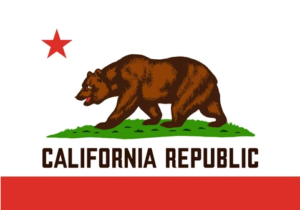
The Bear Flag of the Republic of California
The California Republic is a little-known country that existed for a very short time in history. It only lasted 25 days! It was formed when a group of Americans inhabiting California, then a Mexican territory, rebelled against the Mexican government. The rebellion was started by thirty-three Americans. That thirty-three recruited many more. There were a lot of Americans in California then, even though it was owned by Mexico. This made it easy for them to recruit a small army. Together, they took the city of Sonoma. This military rebellion allowed the creation of a new Republic. The flag for the Republic of California features a walking bear. This flag was designed by a man named Peter Storm. The flag of the Republic of California is still a popular accessory to this day, on posters, mugs, and funny political t shirts. The taking of Sonoma happened with almost no violence. A group of American soldiers rode into Sonoma and found the Mexican comandante, or military officer’s residence. Pounding on his door, they demanded to negotiate terms and declared themselves to have jurisdiction over Sonoma. After forcing this negotiation, the commander on the American Side, William B. Ide, issues the following proclamation to all residents of the area:
He [William B. Ide] also solemnly declares his object in the Second place to be to invite all peaceable and good Citizens of California who are friendly to the maintenance of good order and equal rights (and I do hereby invite them to repair to my camp at Sonoma without delay) to assist us in establishing and perpetuating a “Republican Government” which shall secure to all: civil and religious liberty; which shall detect and punish crime; which shall encourage industry, virtue and literature/
This proclamation amounted to a miniature Declaration of Independence for the short-lived Republic. The flag, first drawn on a piece of cotton cloth, wound up symbolizing the new Republic.
This may sound very unlikely, but it came at a particular point in history. Both the United States and Mexico felt, at the time, that they should own California. A great deal of American immigration was seen as a threat by the Mexicans, whom the Americans at the time frequently referred to as “Spaniards”. The American Secretary of State during all this was a man named James Buchanan, who had instructed his subordinates in to take advantage of any unrest they could find in California. What this all means is that the United States government was looking for any opportunity it could find to create chaos in California and seize the state. There as a lot of international tension at the time, and the short-lived Republic of California was symptomatic of that.
It was a flash in the pan in history, but the Republic of California’s Bear Flag continues to be iconic to this day. It recalls that time in history, and also stands as a symbol for California itself. It can be seen today in many places, including funny political t shirts and other memorabilia.
Is $20 for a t shirt expensive?
Modern screen printing technology has made it cheap to print graphic t shirts. Combined with the internet, which provides access to every graphic you could possibly want, it’s possible to print pretty much anything. Cheap t shirts abound. Why, then, do some t shirts cost $20? Materials are widely available. Screen printing is cheap. There’s a cornucopia of free images online. A $20 shirt seems almost absurd.
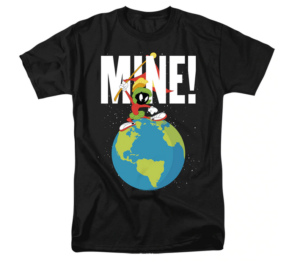
A legitimate, licensed Marvin the Martian shirt
But there are reasons why shirts cost that much, and the biggest one is licensing. It’s not just about goods and services. It’s not just about the material that the shirt is made of and the screen printing process. It’s also about the images, and that’s where the real snare is. Remember that today we live in an information economy. It’s not so much about raw materials anymore. At this point, we’re much more focused on information, on ideas. That’s where the money is. That’s where all the profit is. With most industrialized countries having switched to service economies instead of industrial ones, we’re all about ideas and information.
In order to make money off of ideas, you’ve got to have the idea of intellectual property. This is where we get things like trademarks and copyrights. This is also why we have things like digital rights management (DRM). A lot of people complain about this stuff. Every nerd knows that, back in the 1990s, there was a huge legal hullabaloo over Napster allowing people to download Metallica songs for free. The reason it’s in the news so much is that intellectual property is what our whole world is based on at the moment.
The truth is, though, this stuff is necessary. If your favorite artists, franchises, and brands are gonna exist, they have to make money. And there was a time before intellectual property. Back then, it was very hard for artists to make money. For example, the famous German author, Goethe, made very little money off of some of his books. He made little money even though they were selling well! The reason is that Goethe was writing back in the 1800s. And back then, there were no laws about intellectual property. As a result, even with many of his books being printed and sold, Goethe made little money. Most of that money went to the publishers.
As much of a pain as intellectual property laws can be, they’re important. Not just for the studios and companies and publishers, but for the artists and musicians and actors, for the creators. Those laws and licensing regulations protect the people who create the art you love. $20 might be a lot for a t-shirt, but it’s a worthwhile price to pay to support your favorite creators.
